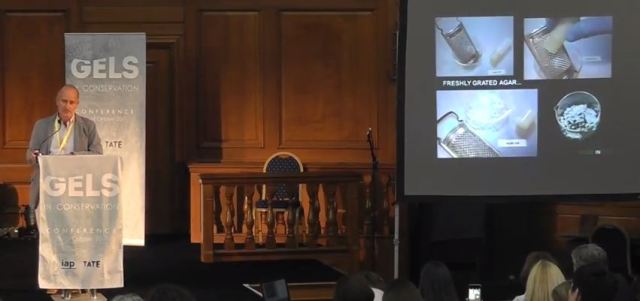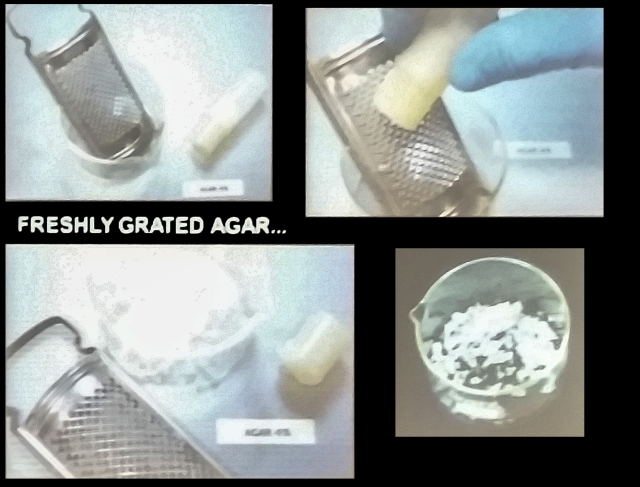This is the second post in a six-part series by member and former MRCG officer Jodie Utter, the Senior Conservator of Works on Paper at the Amon Carter Museum of American Art. Jodie writes about her experience at the London “Gels in Conservation” conference co-hosted by the Tate and IAP (International Academic Projects, Ltd.), including her takeaways and links to videos of many of the presentations on current research in this area. Stay tuned– new parts will be published twice per week!
Part 2: Richard Wolbers and Paolo Cremonesi

At an international conference in mid-October, over the course of three days, some 41 authors presented research, techniques and ideas on the use of gels in conservation. The first presentations of the first day kicked off the conference, setting the tone with intriguing philosophical, as well as practical hands-on examples of gels in conservation. The two leading conservation scientists in the field of gels, Richard Wolbers and Paola Cremonesi, each provided an introduction to gels in conservation, what has been done historically, what is currently practiced, and thoughts for the future. Wolbers not only delivered the key note presentation, but spoke several times as collaborator for many of the talks and as a moderator. In his keynote address, Wolbers emphasized minimizing toxicity through substitution of less toxic materials and Cremonesi discussed the characteristics of agar gels and the current work being done with thermo-reversible rigid agar hydrogels.
Bottom line, it seems that the basic goal for many of the case studies that were presented is to find a way to safely use aqueous cleaning systems on water-sensitive materials without damaging the object. A tall order.

Richard Wolbers presenting.
Wolbers’ talk, “Gels, Green Chemistry, Gurus and Guides,” provided an overview of gels in conservation, as well as a look towards the future, and emphasized the goal of using “green” chemistry, which involves less waste and is less toxic–something he has been advocating for years. (Click here to watch Wolbers’ talk on YouTube.)
Wolbers said, when confronted with a treatment problem, first determine if a gel is appropriate. Gels keep the gel and its contents in contact longer with the surface; gels make local application controllable or they can serve as a poultice. Naturally, the gel used shouldn’t impact the surface medium, and it should be non-toxic and clean the object. Wolbers listed some of the advantages of solid rigid agar gels: they dissolve in water, improve surface wettability, and have surfactant properties.
Ultimately, to do the best by our objects, we as a field need to continually look to other industries for ideas. For example, the cosmetic industry utilizes green chemistry to reduce exposure to potentially harmful solvents. We need to truly understand what we want to achieve in a particular circumstance and tailor it to our object, rather than relying on a few stock recipes and applying them to all situations. As conservators we must remain agile and stay creative. To do this we must understand the underlying principles of the materials we want to use and the objects we are treating. Conservation needs to be able to gain ideas and experience from other fields, and also be able to create and engineer our own materials to give us the type of control we need.

Paolo Cremonesi presenting.
In Cremonesi’s talk, “Thermo-reversible rigid agar hydrogels: their properties and action in cleaning,” he listed the advantages of agar gels: how they dissolve in water and improve surface wettability. As compared to gellan gum they have limited adhesion to the surface and, most importantly, leave behind minimal residue. (See M. Sullivan’s paper “Rigid polysaccharide gels for paper conservation: a residue study”). Past drawbacks of agar gels had been that they could only be applied to relatively flat surfaces. However, if the liquid gel is applied (brushed or poured on) just at the moment it starts to thicken, it can be used on a variety of surfaces, planar or not.
(Click here to watch Cremonesi’s talk on YouTube.)
Thermo-reversible gels are often prepared in the microwave to prepare a homogeneous gel. When heated above 80ºF (Cremonesi recommended type E for its low gelling temperature) the gel is liquid and when cooled below 80ºF it is a solid. With increased concentration, the gel becomes stiffer which will slow the release of water from the gel. While in the liquid form it can be poured into receptacles such as a syringe body. Allowed to cool, once solid it can be kept in a “pencil” shape (this slide caused many audience members to swoon) or be cut into small plugs.

Slide featuring details of grated agar.
At room temperature it can also be grated, with the shaving manipulated for surface cleaning. Enzymes mixed with Agar in a semi-solid state are the most effective form of the material. That said, Cremonesi said gellan gum is more appropriate for works on paper because it’s more flexible and transparent than agar.
One problem I’ve found with using gels (in my case gellan gum) is the formation of tide lines, which made me assume we were doing something wrong. According to both Wolbers and Cremonesi, I was missing a step. They talked about the importance of pre-wetting the surface to be treated with a non-polar solvent (they specifically mentioned D5, a.k.a. decamethylcyclopentasiloxane, a.k.a. cyclomethicone). At first this might seem counterintuitive: how does water work if there’s non-polar solvent in the way? Actually it’s about displacement – oil floats on water – so the water in the gel displaces the non-polar solvent to get to the surface. The non-polar solvent prevents tidelines principally by blocking capillarity. Now it’s all starting to make sense. The same principle was used by Burgio, Rivers, et al. (2008, Studies in Conservation) when consolidating matte paint. On this basis, any non-polar solvent (spot-tested first) should work to prevent tidelines. D5 has the advantage of being a “green” solvent, comes without the H&S hazards associated with hydrocarbon non-polar solvents, and is exceptionally non-polar.
This blog series is a result of receiving the FAIC Carolyn Horton grant to help me attend the conference. I would like to gratefully acknowledge the FAIC for helping make it possible for me to attend this important conference.
You can find videos and more information about the conference talks on this page: http://academicprojects.co.uk/gels-conference/gels-conference-presentations/



You must be logged in to post a comment.